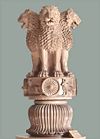
N. Krishnaswamy
Indian Police Service (Retd.)

|
|
N. Krishnaswamy Indian Police Service (Retd.) |
|
| Biography | My Son Natesan | My Police Work | My Social Work | Awards / Recognitions | Extras | Photo Gallery |
|
During the years 2009 and 2010 I
found time to do some serious writing on our ancient scriptural works,
that resulted in books on 1) The Bhagavad Gita, 2) The Rig Veda, 3) The
Vedangas, and 4) The Lalita Sahasranamam. In these books I attempted to
present brief selections from the original works with simple
explanations and perspectives, shorn of complex and esoteric aspects,
for the benefit of the first time reader. I reproduce below copies of my
Preface to each of these books as these would provide an adequate
perspective and overview, to interest the viewer to consider looking,
not for my books but the original works addressed by them.
|
||||||||
|
In 1962 again, when was stationed as Superintendent of Police in
Tirunelveli District, I organized a children’s troupe to present
Rabindranath Tagore’s Bisarjan. My next effort was in 1967 when I was
DIG at Coimbatore, and when I trained the six talented children of
S.M.A.Aslam, the Conservator of Forests
to put on boards the
hilarious comedy, “The Man Who Married a Dumb Wife” by Anatole France,
which had the audience in splits. And finally around 1969, soon after I
returned to Chennai (then Madras) from a posting at N.Delhi, when my
assignment as DIG in charge of the Railways and Armed Police, left me
with a lot of spare time to be able to resume a number of cultural
interests. One was to start a Book Club, for which I have another story.
My last fling at the stage was with Naveen, a drama troupe that I
organized with children of friends of mine, also friends of my daughter
Uma. Two programmes with
this group stood out. One was an ambitious reproduction of the scene of
Satan’s War Council from Milton’s Paradise Lost. Here the children
dressed as devils – with University Convocation Gowns for costumes
delivered the tough lines of Satan and his devil advisers so faultlessly
and with such panache that the knowledgeable audience were astounded.
But what was really important was that it was a great learning
experience for the children in the evocative power of the English
language which no school experience would ever be able to give them.
|
||||||||
|
A last word on the experience of my direct participation in stage
activity that I have hinted at above. This was the occasion of a State
Police Cultural Meet in 1961, when I and my staff
drawn from all ranks in the Madras City Crime Branch donned the
grease paint and full fledged Naga costumes to perform a vigorous Naga
dance, true to the Naga tradition. P.Kuppuswamy, the DIG Armed Police,
who was running the entire programme came backstage to congratulate the
Naga Chief whom led the dance, and he then asked for me so that he could
congratulate me as well. He could not contain his astonishment when he
was told that the Naga Chief was no other than myself as one may see in
the picture below ! Also in the picture is V.G Manoharan, my
indefatigable assistant.
Those were great days, even till the Sixties, when a moral ethos still prevailed in public life, some of us of the post-Independence generation of the Indian Police Service tried our best to bring decency, culture and sophistication into the Police, But alas, the decades that have followed have demonstrated that the new generation of powers-that-be will have none of this. Their attention would appear to be exclusively concentrated on getting into and remaining in power – by hook or crook, for which they needed police forces that would be party to protecting their freedom to function outside the law – one of the prices we have paid for Freedom with a Government by the people, but not quite of the people or for the people ! At Delhi University
This is a brief recollection of my final years in
Of the names given up Sir Maurice Gwyer of course, does not have a role
in story beyond providing us a place for our happy stay for a year.
M.R.Raman was my classmate and closest friend, a lifelong friendship
that ended with his passing away a couple of years ago. We shared the
same room in Gwyer Hall. You can also see me on the right in the seated
row. S.P.Mathur was a
fellow student at the University, and a hostel-mate at Gwyer Hall. I
have changed the name and I
do not point to him in the above photograph
to respect her privacy.
He comes into this story because we were his confidantes in
regard to the severe crush he entertained on Asha Rani (named also
changed for the same reason), the prettiest girl student of the day in
the University. Day after day he would pour out his heart to us, and for
want of experience in these matters, could not offer him any advice,
beyond words of comfort and encouragement that true love would
ultimately prevail. In due course our proclivity for leg-pulling got the better of us and so we faked a letter as from a friend of Asha Rani and sent it to Mathur by post. In the letter, he was invited to a rendez-vous at a particular date and time near the University Gate, corresponding to the girl’s usual time of arrival every day at the University. That was the last time Mathur spoke to us on the subject. It was rumoured that he had attempted a contact, but got ticked off. We felt sorry for Mathur, but realized that these are the hazards of unilaterally falling in love with some one !!
Another hostel mate was Kumar, who was greatly devoted to me as he could
always fall back on me for loans to sustain his need for cigarettes. I
found to my dismay that My friend Raman was also falling into the
cigarette habit, and finally made him kick the habit by threatening to
walk out on him - with a
final persuasive blow coming from news of his chain-smoking elder
brother Narayanan, succumbing to Tuberculosis. Penicillin was still
unknown and TB was generally accepted as the end of the road. |